Oscar-Claude Monet (November 14, 1840 – December 5, 1926) was a French artist who was a leading member of the art movement Impressionism and who is now regarded as one of the greatest artists in the history of western art. A founder of the movement, Monet remained dedicated to Impressionism through his long career. The act of portraying one’s perception of a scene rather than the exact details, which is a quintessential characteristic of Impressionism, is a common motif in the paintings of Monet. Though he began his career as a caricaturist and created some portraits in the early phase of his career, Monet was primarily a landscape painter. Accurate depiction of light and weather conditions; rapid, unmasked brushstrokes; and skillful use of color are some of the elements which may be observed in the paintings of Monet. Here are the 10 most famous paintings of Claude Monet including his renowned Impressionist landscapes.
Note: We use an algorithm to calculate the most popular works of an artist. The “most famous” works are ranked by their current popularity on the web and not when the work was created. You may vote for your favorite painting in the last section of the post. That doesn’t change the ranking of the painting in this post. However, you may view the results of the poll by clicking on “Result”.
#10 Rouen Cathedral Series
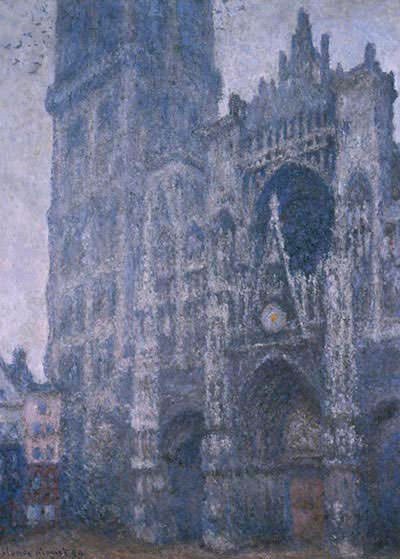
| Years: | 1892 – 1894 |
Monet is know for his series paintings in which he captured the same scene again and again at different times of the day. This reached its peak in the 1890s when such series dominated his output. His most famous series paintings from the time include Haystacks (1891), Poplars (1892) and the Rouen Cathedral Series. The series consists of 31 canvases showing the facade of the cathedral under different light and weather conditions. Though the cathedral had been painted by numerous artists before Monet, he captured it in a very different way. He stripped it from its symbolism making it devoid of religious conviction and national glory. The paintings seem to propose that the cathedral is merely a configuration of elements despite all its fame. The Rouen Cathedral Series has been called “the climax of Impressionism”.
#9 Bain à la Grenouillère
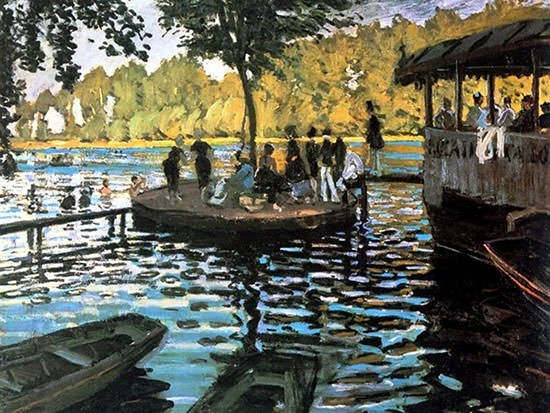
| Location: | The MET, New York City |
| English Title: | Bath at La Grenouillère |
| Year: | 1869 |
La Grenouillère was a boating and bathing resort on the Seine River, outside Paris. In the summer of 1869, Claude Monet and Pierre-Auguste Renoir began sketching beside the water at La Grenouillère. This was a watershed moment in art history as the two developed several of the theories, techniques and practices that would give rise to Impressionism. Both the artists created their version of the resort from the exact view point. This painting is Monet’s version while the version of Renoir is titled La Grenouillere. Both the artists have used rapid, unmasked brushstrokes in their versions, a technique which became integral to Impressionism. Monet, unlike Renoir, has focused more on the light effects and accurate depiction of light is another important characteristic of Impressionist art.
#8 The Magpie
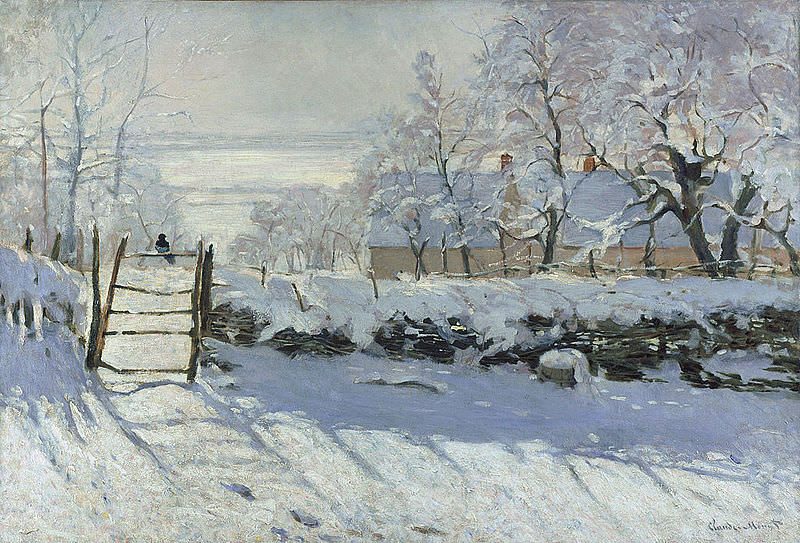
| Location: | Musée d’Orsay, Paris |
| French Title: | La Pie |
| Year: | 1869 |
Magpies are birds of the Corvidae family. This painting depicts a solitary black magpie perched on the gate on a snowy landscape. It was created by Monet in the winter of 1868 – 1869 while he was staying near the commune of Étretat in Normandy. Monet created the painting “en plein air” (outside), which later became a hallmark of Impressionist art. The Magpie was a pioneering piece of art at its time. Among other things, the painting is one of the first examples of Monet’s use of colored shadows. Prior to the Impressionists, painters preferred to use black to illustrate shadow. However, in this masterpiece, Monet has highlighted the multiple shades that he observed and used the complementary colors of blue and yellow to cast the shadows. Colored shadows later became a defining characteristic of Impressionism. The Magpie was rejected by the 1869 Paris Salon and it was also heavily criticized. Today the painting is one of the most popular works of Monet and modern critics regard it as one of Monet’s best snowscapes.
#7 Wild Poppies Near Argenteuil
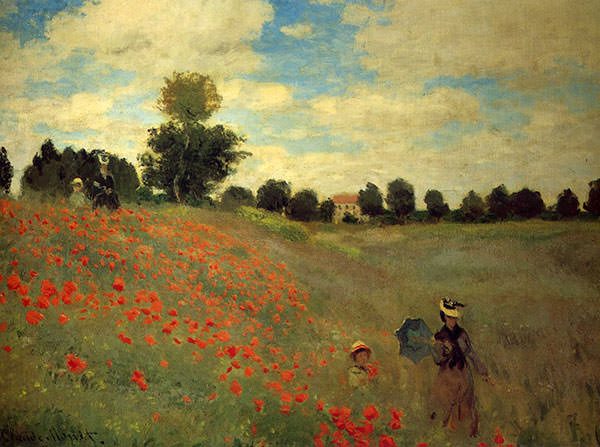
| Location: | Musee d’Orsay, Paris |
| French Title: | Coquelicots sauvages, près de Argenteuil |
| Year: | 1873 |
From 1871 to 1878, Claude Monet lived in Argenteuil, a commune in the northwestern suburbs of Paris. The painting was created a year before the First Impressionist exhibition, in which it was displayed. It depicts a mother and child pair in the foreground and another in the background, but the real subject of the artwork are the natural light and movements of the poppy field. In keeping with Impressionism, the informal brushstroke capture a rapid glance of the scene giving no special status to the figures or the other elements. Evoking a stroll along the fields, Wild Poppies Near Argenteuil is now one of the best known landscape paintings of the 19th century. The painting is historically important as it was one of the first expressions of the style which would later be associated with Impressionism. As such, it is regarded as one of the leading masterpieces of the art movement.
#6 San Giorgio Maggiore at Dusk
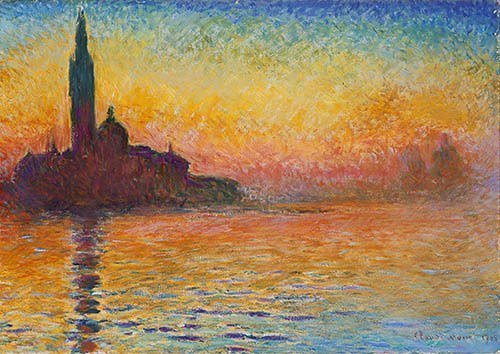
| Location: | National Museum Cardiff, Wales |
| French Title: | Saint-Georges majeur au crépuscule |
| Year: | 1908 |
San Giorgio Maggiore is one of the islands in Venice, Italy. This painting focuses on the Church of San Giorgio Maggiore with its tower at the top left corner. Monet created this masterpiece while visiting Venice in the autumn of 1908. The scene captured seems to have been viewed from the waterfront known as the Riva degli Schiavoni. The painting is a prime example of the art style of Monet and Impressionism. Monet’s focus here is on the accurate depiction of light and the movement in the water. He is not concerned as much with the church as he is with the colors at that time of the day. There are a few versions of the painting with one in possession of a private collector and one on display at the Bridgestone Museum of Art in Tokyo. This version is owned by the National Museum Cardiff in Wales.
#5 The Artist’s Garden at Giverny

| Location: | Musée d’Orsay, Paris |
| French Title: | Le Jardin de l’artiste à Giverny |
| Year: | 1900 |
In 1883, Monet discovered Giverny, a village northwest of Paris. He first rented and then bought a house here, which was to be his home till the time he died in 1926. By the time he painted this masterpiece, Monet had been giving instructions to his gardener for almost two decades to create a spectacular natural environment for him to enjoy and to create landscape art. Lilies had been planted in the pond which were used to create his famous Water Lilies series. In this painting, however, we see rows of irises in various shades of purple and pink, willow trees and a glimpse of Monet’s house beyond the trees. Skillful use of color is one of the highlights of this painting. Deep purple of the lilacs dominate the canvas but other colors like red and blue have also been used. All these have been merged skillfully to create a spectacular landscape. It is to be noted that The Artist’s Garden at Giverny is more well defined as compared to other works of Monet in his late career, which are more abstract.
#4 Woman with a Parasol
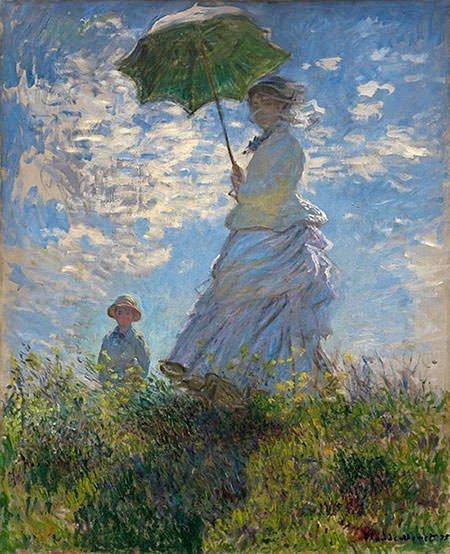
| Location: | National Gallery of Art, Washington, DC |
| French Title: | La Promenade (The Stroll) |
| Year: | 1875 |
Genre painting is a form of art which depicts ordinary people doing everyday activities. Woman with a Parasol is more a genre painting than a formal portrait. It may also be seen as a hybrid of portraiture and landscape art. Its full name is Woman with a Parasol – Madame Monet and Her Son. As the name suggests, it depicts Monet’s first wife Camille and their eldest son Jean Monet. Camille is holding a parasol or a light umbrella. It seems that she and her son are interrupted in their stroll as they look at the artist while he captures the moment. From 1871 to 1878, Claude Monet lived in Argenteuil, a commune in the northwestern suburbs of Paris. Woman with a Parasol was painted during this time. It was probably created in a single session of several hours. The painting appeared in the second Impressionist exhibition in 1876 and was well received. It is now perhaps Monet’s most famous work which is not a landscape.
#3 Haystacks
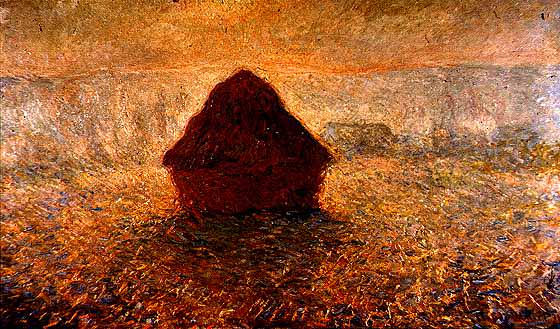
| French Title: | Les Meules à Giverny (The Stacks at Giverny) |
| Years: | 1890 – 1891 |
The Haystacks series is one of the most acclaimed works of Claude Monet. It refers primarily to 25 canvases which he began painting in late September or early October 1890 and continued for around seven months. The primary subject of the paintings is stacks of harvested wheat in the field near his house at Giverny. The series captures the mundane subject to show differences in perception of light across various times of day, seasons and types of weather. To do so, Monet used to get up before dawn so he could begin at the earliest time of day. He then switched to later canvases as time progressed. He thus sometimes worked on as many as 10 to 12 paintings in a single day. The Haystacks was the first group of paintings that Monet exhibited as a series. 15 paintings of the series were shown at the Galerie Durand-Ruel in Paris. The series was a financial success at the time and now various museums across the world house its paintings.
#2 Impression, Sunrise

| Location: | Musée Marmottan Monet, Paris |
| French Title: | Impression, soleil levant |
| Year: | 1872 |
As their radical works were not being accepted at the Salon, Monet and others decided to organize an independent exhibition alongside the Salon. The paintings displayed were lambasted by the critics. Impression, Sunrise was at the heart of one critic’s ridicule as he wrote: “A preliminary drawing for a wallpaper pattern is more finished than this seascape.” The rebels took the criticism in their stride and named their movement Impressionism on Monet’s painting. Though not regarded as among the best works of Monet by some, Impression, Sunrise is among the most famous paintings in the world for giving its name to one of the most prominent movements in art history. It depicts the port of Le Havre in north-western France at dawn. There are several details in the painting which makes it characteristically Impressionist. Short, thick brushstrokes are used by Monet to capture the essence of the subject. The choice of subject, painting plein-air and the distinct application of color are other factors in the artwork in keeping with the Impressionist movement.
#1 Water Lilies
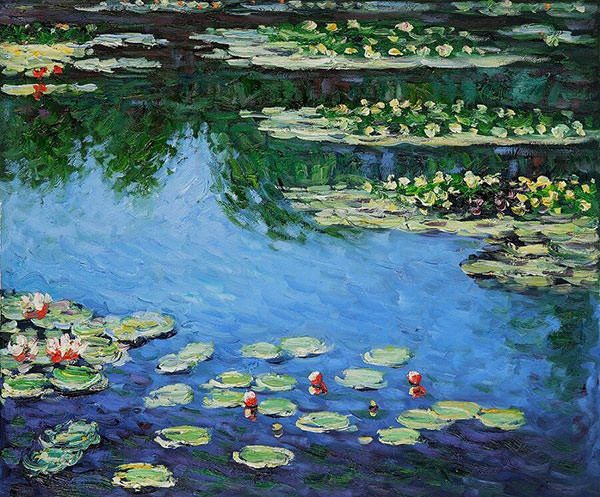
| French Title: | Nymphéas |
| Years: | 1897 – 1926 |
Monet build an exquisite natural environment around his home in Giverny with an elaborate garden, a pond and a wooden Japanese bridge. For 30 years, between 1897 and his death in 1926, Claude Monet produced more than 250 oil paintings of his lily ponds and his Japanese bridge, executed in different sunlight and at different times of the day. In the early paintings of the series (1897–99), he captures the pond environment with its plants, bridge and trees neatly divided by a fixed horizon. However, with time, he became less concerned with conventional pictorial space and the late paintings of the series combine Impressionism with Expressionism and are on the verge of being abstract. The dazzling complexity of color and light in the “Nymphéas” panels opens the viewer’s eyes to the incredible diversity of nature and to the depth and mystery of the life it sustains. An amazing thing about these works is that Monet’s eyesight was badly deteriorating due to cataract while he painted most of these masterpieces. The Water Lilies Series, the most renowned work of Claude Monet, are regarded as “the Sistine Chapel of Impressionism”. Among other things, they were hugely influential to the following generations of modern artists.

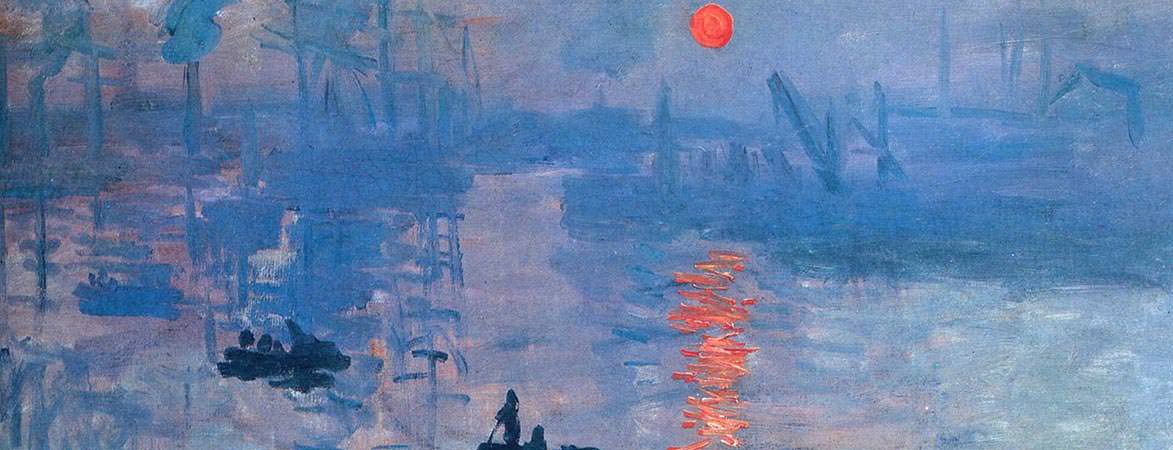
You show/have the best and my favorite paintings is the whole world!